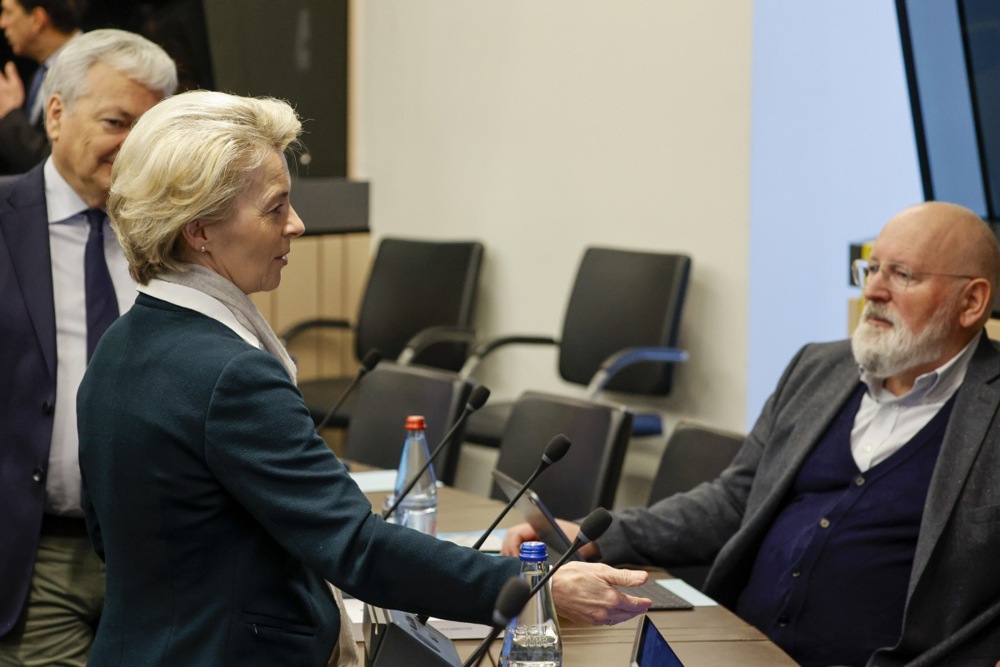European Commission President Ursula von der Leyen wants a radical reform of the EU budget to give herself more power and to enforce specific political objectives from Brussels.
An internal presentation by the European Commission, seen by the German newspaper Frankfurter Allgemeine Zeitung (FAZ), shows von der Leyen is planning far-reaching changes for the EU.
Member states would only receive European funds after coordinating a far-reaching list of their national plans for development, housing, immigration, transport, energy and more with the commission. The commission would lay out goals and reforms. Only when these are sufficiently adhered to would the countries receive their money.
This approach contrasts with the current system, where recipients receive funds based on meeting predetermined, objective criteria, following an impartial and standardised distribution process.
Brussels has been using such conditionality to punish countries that do not obey the EU, such as the current government of Hungary, and the previous government of Poland, regarding migration and justice policy.
It would lead to the de facto abolishment of independent European subsidies for farmers and regions, the two most important items of the current budget, accounting for around one-third of its expenses.
In the plans, these European subsidies would be transferred to the EU member states as a kind of subsidy to the national budget, akin to the Corona Recovery Fund, which comes with strings attached.
By doing this, the commission would demand that receivers of the funds agree in advance on national plans with political reforms and goals set by Brussels.
However, FAZ reports that sources within the commission downplay the plans as “brainstorming”.
The budget would also include three additional components: the Competitiveness Fund, foreign policy initiatives under the “Global Europe” heading, and administrative costs.
The Competitiveness Fund is intended to consolidate all existing programmes that promote competitiveness in the broadest sense and will incorporate research initiatives, digital programs, space funding, the Innovation Fund, and the Investment Fund launched under former Commission President Jean-Claude Juncker.
Additionally, the European Defence Fund will be absorbed into this new fund.
With this, the commission would utilise its hold over resources to pursue specific policy objectives, thereby concentrating substantial policy and spending power within its purview.
Regarding agriculture and regional development, the Commission would take its hands off the administration and design of the support, reducing them to components of national plans.
It would give money as aid, similar to what already is happening, but introduce conditions, for example, obliged promotion of organic agriculture. A similar method would be used for transport, social affairs, energy or security and migration.
In the presentation, as a way of illustration, aid with the construction of a railway line is linked to the condition of simplifying public procurement, aid for social housing will be linked to the closing of the wage gap between men and women, and aid for reception camps for migrants with the strengthening of cross-border cooperation.
According to the commission, this restructuring would reduce the internal level of bureaucracy.
Instead of 530 European programmes, there would only be 27 national plans, one per member state. It would reportedly give countries more flexibility to use the funds, for example with the recent floods.
More flexibility would also be introduced by making annual adjustments to the financial framework, instead of the seven-year term which is being used now. This should give more leeway in case of unexpected crises, like those brought about by war or a financial downturn.
Negotiations on the EU financial framework would also be easier because the European Parliament and the Council of Ministers would no longer have to negotiate hundreds of programmes.
The European Commission would only have to determine how much money goes to the budget items in total and how much each state subsequently receives in budget subsidies. Once distributed, there would be no more need for European oversight.
The European Court of Auditors has repeatedly criticized the “money for reforms” approach of the Corona Fund for this very reason, noting that the risk of errors is high when the EU pays money to states as soon as they fulfil certain reforms and complete individual stages of associated projects, rather than reimbursing project costs afterwards, as has been the practice in the EU budget.
Regions likewise do not seem keen on the changes. “If this is true, it weakens cohesion policy,” the President of the European Committee of the Regions, Portuguese Vasco Alves Cordeiro, said. “It doesn’t put regions at the centre of policy; it scandalously side-lines them.”
The presentation did not indicate how large the budget should be. However, it reportedly assumes that the previous ceiling of slightly more than one percent of the EU’s economic output will be maintained, FAZ notes, while questions persist on Ukraine and the repayment of loans for the Corona Fund.
The next EU budget proposal is set for 2025, with the European Commission proposing an annual budget of nearly €200 billion for that year. The detailed budgetary discussions and final decisions are expected to take place throughout 2024.





